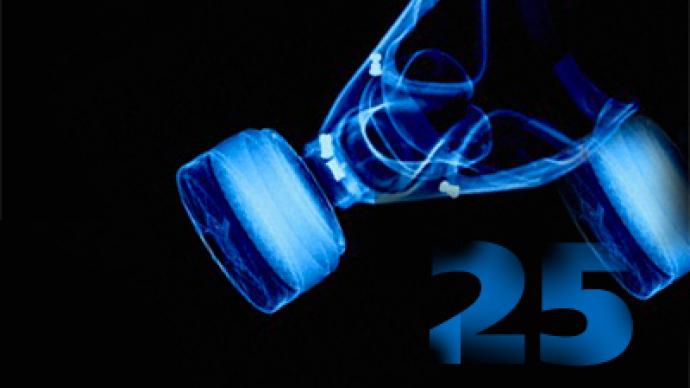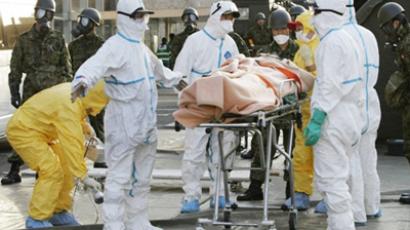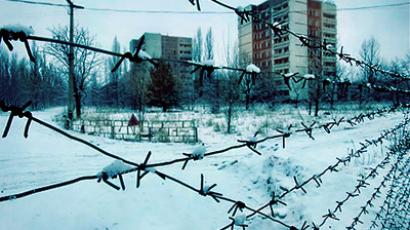Marking 25 years since Chernobyl catastrophe

A quarter of a century ago the world awoke to the worst nuclear accident it has ever seen. Commemoration services are being held on Tuesday throughout the region.
The explosion at Chernobyl sent a huge plume of radioactive smoke across much of Europe, leaving the land in the 30-kilometer exclusion zone poisoned for thousands of years.Some six weeks have passed since the world witnessed another nuclear disaster unfold around Japan’s Fukushima-1 nuclear power plant. Today, the tension shifts to Ukraine, as the country marks the 25th anniversary of the Chernobyl catastrophe. Commemorations in Kiev began exactly at the time when the disaster happened 25 years ago – at 1:23am, when an explosion blew the roof off reactor 4.The service was led by Russian Orthodox Patriarch Kirill near a monument to firefighters and cleanup workers who died soon after the accident from radiation sickness. Russian President Dmitry Medvedev has joined his Ukrainian counterpart Viktor Yanukovich for a memorial ceremony in Chernobyl.“The labor of a huge amount of citizens from Ukraine and Russia was put in to deal with the aftermath of this tragedy,” said President Dmitry Medvedev at a commemoration ceremony in Chernobyl, praising those who risked their lives cleaning up after a nuclear explosion shook the Soviet nuclear plant. “In the face of such disasters, we should be honest – it is the government’s obligation to tell people the truth. We need to admit that back then, the government was not always doing the right thing.”In April 1986, a fire that raged for a week and a half spewed vast amounts of radiation into the air – 200 times the amount of radiation from the nuclear bombs dropped on Hiroshima and Nagasaki, according to Greenpeace.Approximately 8.5 million people in Ukraine, Russia and Belarus were exposed to high levels of radiation. Thirty-two lives were lost immediately and 30 more in the weeks following the accident. Some 600,000 liquidators worked at different times on the site to put out the fire and clean the area.Estimates as to the total number of deaths that potentially resulted from the accident vary enormously. The World Health Organization puts it at 4,000, Greenpeace at 200,000, while independent Russian publications go up to 985,000 deaths.
The ghost town of Pripyat
Twenty-five years ago the town of Pripyat was a place any Soviet person could dream of: high salaries, great standards of living and impressive infrastructure – a restricted town for the employees of the Chernobyl nuclear power plant.Pripyat was regarded as the pride of the Soviet Union. It was not only constructed to look like a perfect socialist city, but the people who lived there were also the best of the best. The best musicians, sportsmen, professionals in nuclear energy – many of them lived there.All of that changed on April 26 when the Chernobyl reactor exploded – the result of an experiment carried out in the wrong hands.“The reactor was almost completely out of control on April 25. But it could still have been saved,” a nuclear physician and Chernobyl liquidator Boris Gorbachev told RT. “The management pushed for completion of an experiment. Personnel hesitated and were reluctant, but eventually couldn’t go against the authorities. We all know the result.”Meanwhile, the town’s population had no idea about the disaster. People were enjoying an unusually sunny Saturday outdoors. Aleksandr Sirota, a former resident of Pripyat, recalls that day:“Me and my friend, we ran away from school to play at a beach. We returned home all covered in mud. My mother asked me where I had been. I lied that we were cleaning the school yard. She was shocked as she had already heard rumors of some accident at the nuclear station.”That shock was easy to understand. Ambulances with sirens had alarmed the population of the small town. In the middle of the night, they delivered the severely injured plant workers and firefighters to the hospital.“People had different wounds – fractures, burns and irradiation,” says Vitaly Leonenko, the head physician at Pripyat hospital from 1980-1986. “Most of them had third and fourth degree radiation burns. One of them died instantly, the others had to wait 24 hours to be evacuated to a hospital in Moscow.”Ironically, those were the lucky ones. Others stayed in the city exposing themselves to deadly doses of radiation. Many died or suffered radiation sickness afterwards.Nowadays, Pripyat is described as a dead town. Nobody lives there and never will again: the half-life period of many nuclear pollutants there reaches tens of thousands of years.That does not scare Matrena Korneenko, who returned to the area right after the USSR collapsed.“They gave me a flat and a pension. But I found it impossible to survive like that in Kiev. Here, I have a cattle and I grow everything,” she explained. “Radiation? Yes, there is a little here. But you won’t find a place without it anywhere. We are not scared.”In the wake of the Fukushima disaster, the word Chernobyl echoed again worldwide. Just when everyone thought all mistakes had been learnt, another crisis put the nuclear energy issue through serious debate.But the former Chernobyl liquidators say they are ready to fly half way across the planet to help Japan, just like they did in their own backyard 25 years ago. All they want is to make sure nightmares like Chernobyl and Fukushima never happen again.See RT gallery “Undiscovered Chernobyl”
Fukushima repeating 25-year-old mistakes
RT spoke to journalist James Corbett in Osaka, Japan, who says that the way Japan handles its own nuclear crisis is repeating the 25-year-old mistakes of the Soviet government.“I think the real analogy to be drawn here is the flow of information that’s coming from the government, and it’s not an analogy that favors the Japanese government. In the immediate wake of the Chernobyl disaster we saw that the official Soviet reaction was to attempt to cover up and deny what was going on,” he said. “But once it became apparent – the scale and scope of what was happening – we saw that kick-start the new era of Glasnost and openness, whereas we see the exact opposite thing happening here with the Japanese government’s reaction to what’s happening.”The same approach, Corbett continued, is being seen with the Fukushima disaster.“Even if the Chief Cabinet Secretary Edano is giving twice daily briefings on what’s happening at Fukushima, those briefings are only open to the selected group of Japanese media organizations. Foreign media and independent journalists are being excluded from those meetings, and they are only getting access to second-hand information from administrative sources,” the journalist explained.














